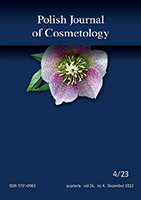search by
Copyright @ Pol J CosmetolSea buckthorn (Hippophae) - a valuable raw material for cosmetic preparationsMagdalena Sikora 1/, Anna Podsędek 2/, Małgorzata Graczykowska 1/, Jacek Krzciuk 3/ 1/ Instytut Podstaw Chemii Żywności, Wydział Biotechnologii i Nauk o Żywności, Politechnika Łódzka 2/ Instytut Biochemii Technicznej, Wydział Biotechnologii i Nauk o Żywności, Politechnika Łódzka 3/ Naturex S.C. Katowice Summary Introduction. Sea-buckthorn berries are characterized by a high content of biologically active substances including vitamins C, E, B group, tocopherols, carotenoids, flavonols, catechins, phenolic acids. Aim. The aim of the study was to determine the chemical composition of the extract and the oil obtained from sea-buckthorn, and to assess the potential use of these components in the emulsion of cosmetic formulations. Materials and Method. The sea-buckthorn extract used in the study came from the Naturex company in Katowice. The content of active ingredients responsible for activity of the raw material has been determined. The spectrophotometric method was employed for determination of the content of total polyphenols. The amount of flavonols, hydroxycinamic acids, hydroxybenzoic and flavanols was determined by high performance liquid chromatography (HPLC). In order to determine the fatty acid content, the oil was subjected to transesterification and gas chromatography in combination with mass spectrometry (GC/MS) was used as an analytical method. Cosmetic preparations were made in the Laboratory of cosmetic raw materials, Faculty of Biotechnology and Food Sciences, Technical University of Lodz. The components used to prepare the formulations were generally commercially available cosmetic raw materials. Results. Sea buckthorn extract used in the preparation of cosmetic formulations contained 147.38 mg/ 100 ml of polyphenolic compounds. The total amount of polyphenols was 79.75 mg/100ml. Flavonols were dominated group of polyphenolic compounds determined by HPLC. The second group, in terms of quantity, were flavanols and hydroxybenzoic acids. As can be seen from the GC/MS analysis, tested oil is dominated by palmitic and palmitoleic acid, that are the specific components of fruit (pulp, the soft part) of sea buckthorn. Conclusion. On the basis of the study it can be concluded that the extract of sea buckthorn, has a strong antioxidative properties, so that effectively protects the cosmetic preparations which, moreover, provide good cosmetic results. Key words: Sea buckthorn extract, Sea buckthorn oil, polyphenols, cosmetics |




